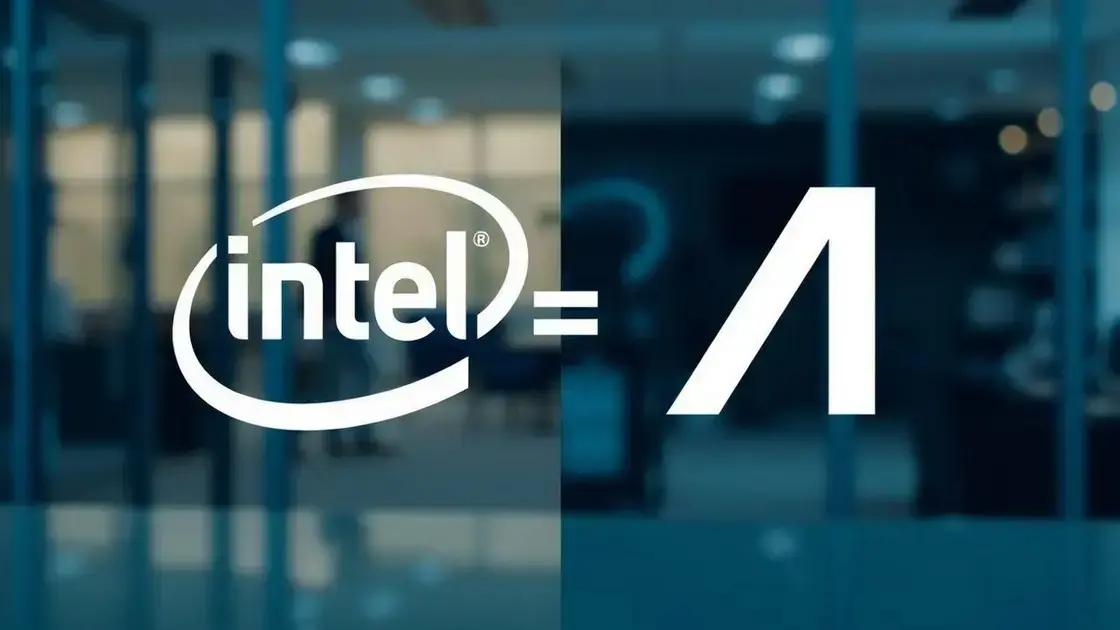Intel sells majority share in Altera business division

Anúncios
Intel sells the majority share in Altera, allowing the company to refocus on core business areas like AI and data centers while enabling Altera to enhance its FPGA technology and explore new market opportunities.
Intel sells majority share in Altera business division marks a pivotal moment for the tech giant. Have you ever wondered how such moves influence the market dynamics and innovation in technology? In this article, we’ll delve into the implications, industry reactions, and what it means for the future.
Anúncios
Overview of Intel and Altera’s partnership
The partnership between Intel and Altera is a fascinating journey in the tech industry. Together, they’ve pushed the boundaries of innovation, enhancing semiconductor technology and product offerings. This relationship started back in 2015 when Intel acquired Altera, aiming to combine their strengths in technology.
One of the key aspects of their partnership has been the development of Field Programmable Gate Arrays (FPGAs). These devices allow for customizable hardware solutions, making them invaluable for various applications, from data centers to automotive technologies. By integrating Altera’s expertise, Intel enhanced its portfolio significantly.
Anúncios
Benefits of the Intel-Altera Partnership
This collaboration not only fostered innovation but also created numerous benefits for the companies involved and their customers. Here are some significant advantages:
- Enhanced Performance: The integration of FPGAs enabled higher processing speeds and efficiency in computing tasks.
- Increased Flexibility: Booting up new features was quicker and more adaptable, allowing businesses to stay competitive.
- Scalability: Customers could customize solutions to fit their specific needs, boosting their operational capabilities.
Moreover, as technology evolves, the partnership has consistently adapted to meet modern demands. This flexibility has allowed both companies to remain relevant in an ever-changing market. The synergy between Intel’s advanced manufacturing and Altera’s cutting-edge design has created a framework for future innovations.
As we look at the developments since the acquisition, it’s clear that their work together has not only redefined their own business models but has also influenced industry standards. It’s intriguing to observe how their collaboration continues to shape technologies that we rely on today.
The journey of Intel and Altera showcases the power of strategic partnerships in the tech world. Their combined efforts have paved the way for unparalleled advancements and continue to inspire others in the industry to follow suit.
Impact of the majority share sale on the industry
The sale of the majority share in Altera by Intel has significantly impacted the tech industry, altering market dynamics and corporate strategies. This change is not just about the ownership shift; it symbolizes a new direction for both companies involved and sets a precedent for future acquisitions.
One major effect of this sale is the increased competition it creates in the semiconductor market. With Intel’s divestment, other companies are poised to capitalize on opportunities that arise from Altera’s innovative technologies. This can lead to a surge in innovation as rival companies seek to fill the gap Intel has left in the market.
Market Reactions
Immediately following the announcement, market analysts and investors responded with mixed feelings. Some investors viewed the move as a smart strategy to focus on core operations, while others worried about losing Altera’s advanced capabilities.
- Investor Concerns: Fluctuations in share prices can indicate uncertainties regarding future growth and innovation.
- Strategic Shifts: Companies must adjust their business models to remain competitive, leading to new opportunities and threats.
- New Collaborations: The change may initiate partnerships and collaborations among competitors, aiming for technological advancements.
Furthermore, the impact on research and development budgets is noteworthy. Following the sale, both Intel and Altera will need to reassess their funding strategies. The shift may result in a renewed focus on core areas, but it could also create budget constraints for new projects. This can influence the pace at which new technologies are brought to market.
As competitors emerge with a keen interest in Altera’s technology, the industry could witness a wave of new products tailored to user needs. Potentially, this environment fosters an era where companies strive to provide customized solutions, driven by market demands. Changes in leadership and vision at Altera can also pave the way for innovative approaches in semiconductor technology.
Ultimately, the sale is a turning point that reflects evolving trends within the industry. It highlights the need for companies to be agile and innovative in a rapidly changing market landscape.
What this means for Intel’s future strategy

Understanding what the majority share sale in Altera means for Intel’s future strategy is vital for anyone interested in the tech industry’s evolution. This decision marks a significant shift, helping Intel to refocus its core business model while leveraging opportunities in emerging technologies.
One major aspect is Intel’s intention to streamline its operations. By selling a controlling stake in Altera, Intel can concentrate resources on enhancing its leading position in CPUs and semiconductor manufacturing. This change is crucial as it allows for increased investment in research and development in areas like artificial intelligence and machine learning.
Potential Shifts in Focus
Intel’s strategy will likely evolve to emphasize several key areas. These include:
- Core Product Lines: Intel is expected to prioritize its microprocessor business, enhancing performance and efficiency.
- Data Center Solutions: There is a growing demand for high-performance computing, particularly in data centers. Intel may invest heavily here.
- Emerging Markets: New markets, especially in AI and IoT, present vast opportunities for growth.
This strategic pivot opens doors to more collaboration with outside partners. As Intel seeks to innovate, working with startups and other firms could lead to enhanced technologies that benefit multiple sectors, not just semiconductors.
Additionally, the sale could have implications for Intel’s supply chain. Streamlining operations may result in cost savings and faster product cycles. This agility in responding to market demands is essential in a competitive landscape.
Furthermore, public perception plays a vital role in corporate strategy. As Intel redefines its focus, maintaining investor confidence is paramount. The successful transition from the Altera partnership will signal to the market that Intel remains a formidable player in tech innovation.
In summary, the sale of the majority share in Altera pushes Intel towards a future where it can better capitalize on its strengths. The company’s strategic decisions will shape how it navigates challenges and seizes opportunities in the fast-paced technology sector.
Reactions from industry experts and analysts
The reactions from industry experts and analysts regarding Intel’s majority share sale in Altera have been varied and insightful. Many experts are looking closely at how this decision will shape the future of semiconductor technology and the broader tech landscape.
Some analysts believe this move reflects Intel’s commitment to focusing on its core competencies, while others express concerns about potential consequences. It’s essential to understand these perspectives to grasp the full impact of this decision.
Positive Reactions
Several experts view the sale positively. They argue that:
- Strategic Focus: Intel can concentrate more on its microprocessor business, improving performance and innovation.
- Increased Agility: The company can pivot more rapidly to emerging technologies in AI and data centers.
- Resource Allocation: Funds from the sale can be redirected to critical areas that foster growth and innovation.
By focusing resources on high-demand sectors, Intel can maintain its competitive edge and potentially lead in various markets.
Concerns Raised
On the other hand, some analysts express valid concerns about what this might mean for Intel’s future. Key points include:
- Loss of Expertise: Selling Altera could mean losing valuable expertise in FPGA technology that could benefit Intel.
- Market Competition: Competitors may seize the opportunity to innovate and capture market share.
- Investor Confidence: There could be negative impacts on investor sentiment if the transition isn’t well-managed.
The balance between these perspectives is crucial. While some experts see a clear path forward, others warn of potential pitfalls along the way.
Ultimately, the varied reactions highlight the complexity of this strategic decision. As analysts continue to monitor the situation, the tech industry will be closely watching how Intel navigates its next steps. The insights from these experts underscore the significance of this share sale in shaping the future for Intel and the semiconductor market as a whole.
Insights into the Altera division post-sale
After the sale of the majority share in Altera, many are eager to understand the future landscape of the Altera division. This transition is not just about ownership; it reflects a new phase of innovation and growth potential for the division.
One primary focus for Altera will be to leverage its expertise in Field Programmable Gate Arrays (FPGAs). These devices are crucial for many applications, including telecommunications, automotive, and data centers. The ability to customize hardware solutions has never been more important, and Altera aims to enhance its offerings in this competitive field.
Key Areas of Development
Post-sale, the Altera division is expected to concentrate on a few critical areas:
- Enhanced Product Offerings: By refining their FPGA technology, Altera hopes to provide even more powerful and flexible solutions.
- Increased Collaboration: Building partnerships with other businesses will enable Altera to innovate faster and remain competitive.
- Focus on Market Needs: Understanding and addressing current market demands will be pivotal for Altera’s continued relevance.
As the Altera division moves forward, its leadership will likely place a strong emphasis on R&D. The goal will be to attract talent and foster a culture of innovation that encourages breakthrough solutions.
Interestingly, the sale might allow Altera to operate with greater autonomy. This independence could lead to more agile decision-making processes, enabling them to respond quickly to market changes and customer needs. Adapting to an ever-evolving technological landscape will be crucial for survival and success.
Moreover, industry analysts speculate that this shift could create exciting opportunities for Altera to explore new markets and applications. With a dedicated focus on FPGA advancements and improved customer engagement, the division can enhance its standing in various sectors.
FAQ – Insights on Intel’s Sale of Altera
What does the sale of Altera mean for Intel?
The sale allows Intel to focus on its core business and invest in high-demand areas like AI and data centers.
How will Altera benefit post-sale?
Altera is expected to enhance its FPGA technology and explore new market opportunities as a more independent entity.
Are there any risks associated with Intel’s decision?
Yes, analysts are concerned about the potential loss of expertise and how competitors may seize market opportunities.
What impact might this sale have on the semiconductor industry?
The sale could reshape competitive dynamics, leading to increased collaboration and innovation among rivals.






